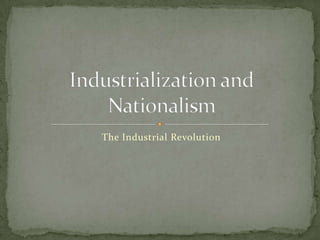
Industrialization and nationalism
- 2. Major job was agriculture Husband, wife and children worked along side of each other Little food was produced just enough to survive if there were leftovers they were sold there was little incentive (motive) to increase production
- 3. Shift from agricultural based economy to manufacturing based economy Starts in Britain Expansion of farmland, good weather, improved transportation and new crops led to an increase in the food supply Population grew Britain had ready money (capital) that they could invest in industrial machines and factories Natural resources were plentiful Rivers Supply of markets
- 4. domestic system also known as the “putting- out system” people worked from their homes, generally during the winter months, production costs were low spinning jenny and the water frame these inventions led to the beginning of the factory system an organized method of production that brought together workers and machines under the control of managers Steam engine allowed for machinery to be driven and not have to be located by a river
- 6. Steam engine created an increased need for coal Locomotives Puddling became possible to create a better quality of iron Britain was then able to produce more high quality iron than the rest of the world combined
- 7. Railroads Created new jobs increased need for coal Electricity Generator Morse code Light bulb Electric streetcar
- 8. The British parliament passed laws to keep its inventions and processes a secret Belgium went at the same rate as Britain and was comparable France most workers remained in agriculture Germany United States The Northeast
- 9. Cities grew larger because of the mills and workers needed Rural areas were changed to cities and towns Housing shortages, bad water and sewers Child labor was cheaper, and easier to get/train Children were routinely beat Increases in levels of alcoholism, prostitution, divorce and crime
- 11. Rise of industrial capitalism Economic system based on industrial production Made up of people who built factories, bought the machines and figured out where the markets were Not to be confused with the industrial working class Worked 12-16 hours a day No security of employment, no minimum wage Cotton mills were the worst “in the cotton-spinning work, these creatures are kept, 14 hours in each day, locked up, summer and winter, in a heat of from 80-84 degrees” Dirty, dusty, dangerous and unhealthy
- 13. Coal mine conditions were also harsh Men still had to dig out the coal even with the new machines Horses, women, children, mules hauled the coal carts on rails to the lift Cave-ins, explosions and gas fumes
